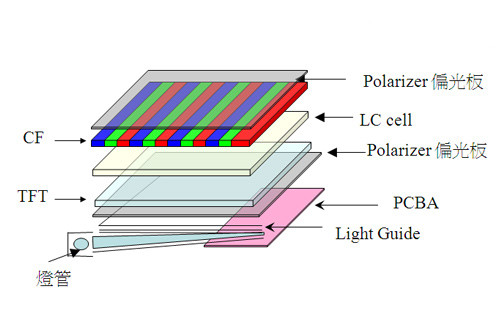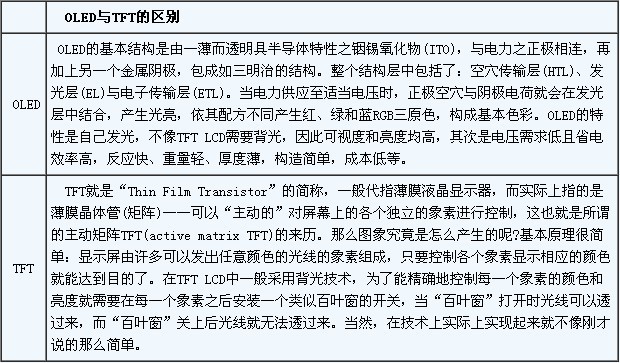Tags: OLED TFT
This article refers to the address: http://
Principle of liquid crystal display
Liquid crystal is a substance between a solid state and a liquid state. It is an organic compound having a regular molecular arrangement. If it is heated, it will exhibit a transparent liquid state, and if it is cooled, a turbid solid state of the crystal particles will occur. Because of this characteristic, it is called Liquid Crystal. The structure of the liquid crystal molecules used in the liquid crystal display is similar to that of a fine match stick, which is called a Nematic liquid crystal. A liquid crystal display manufactured by using such a liquid crystal is also called an LCD (Liquid Crystal Display). In the liquid crystal television, a voltage is applied to the liquid crystal between the two glasses, and the screen is reproduced by molecular arrangement change and zigzag change. The screen is created by the collision of the electron group, and the screen is formed by the perspective reflection of the external light.
Classification of liquid crystal displays
There are four common types of liquid crystal displays; TN-LCD (Twisted Nematic-LCD, Twisted Nematic LCD); STN-LCD (Super TN-LCD, Super Twisted Nematic LCD); DSTN-LCD (Double layer STN- LCD, double-layer super twisted nematic LCD); TFT-LCD (Thin Film Transistor-LCD). The three basic display principles of TN-LCD, STN-LCD and DSTN-LCD are the same, except that the twist angle of the liquid crystal molecules is different. The liquid crystal molecules of the STN-LCD have a twist angle of 180 degrees or even 270 degrees. The TFT-LCD uses a different display method than the TN series LCD.
TN is usually applied to electronic watches and calculators because it cannot display delicate characters. As the display TN series of liquid crystal displays have been basically eliminated, STN due to the large twist angle, the character display is more delicate than TN, but also supports basic color display, mostly used for LCD TVs, LCD monitors, handheld game consoles and so on. The subsequent DSTN and TFT were widely used as liquid crystal display devices. The DSTN liquid crystal display is mostly used in early notebook computers. It is also called pseudo color display because of the limited number of colors supported. TFT is a kind of LCD, also called true color screen. In brightness, but the angle is stronger than the other. TFT can be applied to notebook computers and gradually enter the flat-panel TV market and become mainstream.
LCD liquid crystal display
LCD is the full name of liquid crystal display: it includes TFT, OLED, UFB, TFD, STN and other types of liquid crystal display.

LCD principle
Liquid crystal displays (LCDs) are now very common displays. It has the advantages of small size, light weight, low power consumption, low radiation, and easy to carry. The principle of a liquid crystal display (LCD) is quite different from that of a cathode ray tube display (CRT). The LCD is a display device based on the electro-optical effect of liquid crystal. The character segment display device including the segment display mode; the character display, the graphic, the image display device in the matrix display mode, the large-screen liquid crystal projection television LCD screen in the matrix display mode, and the like. The working principle of the liquid crystal display is to utilize the physical properties of the liquid crystal, and conduct electricity when energized, so that the liquid crystal alignment becomes orderly, and the light is easily passed; when not energized, the arrangement becomes chaotic and blocks the light from passing. The following describes the working principle of the three liquid crystal displays.
T FT thin film transistor
A TFT (ThinFilm Transistor) thin film transistor is one of the active matrix type liquid crystal displays AM-LCD. The TFT is provided with a special light pipe on the back of the liquid crystal to control the individual pixels on the screen "actively". It is the origin of the so-called active matrix TFT (activematrix TFT), which can greatly improve the reaction time. The reaction time of the TFT is relatively fast, about 80ms, and the STN is 200ms. If it is to be improved, there will be flickering.

TFT panel principle
Moreover, since the TFT is an active matrix LCD, the arrangement of the liquid crystals is memorable, and does not return to the original state immediately after the current disappears. TFT also improves the STN flicker (water ripple)-blurring phenomenon, effectively improving the ability to play dynamic pictures. Compared with STN, TFT has excellent color saturation, reducing power and higher contrast, but the disadvantage is that it consumes more power and costs.
TFT-LCD technology is a technology that combines microelectronics technology with liquid crystal display technology. People use the technology of microelectronics fine processing on Si to transplant TFT arrays on large-area glass, and then use the mature LCD technology with the array substrate and another substrate with color filter. Forming a liquid crystal cell in combination, and then going through a post-process such as polarizing film coating, etc., and finally forming a liquid crystal display (screen).
In a TFT-LCD, the function of the TFT is equivalent to a switching transistor. A commonly used TFT is a three-terminal device. A semiconductor layer is generally formed on a glass substrate, and has a source and a drain connected thereto at both ends thereof. And a gate insulating film is opposed to the semiconductor and a gate electrode is provided. The current applied between the source and drain electrodes is controlled by the voltage applied to the gate.
In summary, TFT-LCD is different from the simple matrix of passive TN-LCD and STN-LCD. It has a thin film transistor (TFT) on each pixel of the liquid crystal display, which can effectively overcome the non-gating time. Crosstalk makes the static characteristics of the display LCD independent of the number of scan lines, thus greatly improving the image quality. The characteristics of the switching unit (ie, TFT) are required to meet the requirements of low on-state resistance and very large closed-state resistance.
Following the LCD and LED, the OLED era is coming to us. The OLED scientific name is organic light-emitting diode. This new generation display technology after CRT (negative ray tube) and LCD (liquid crystal display) has high resolution, fast response, ultra-thin, low temperature resistance, rich color and power consumption. The amount is small, flexible display can be realized, and behind many advantages, there is a huge industry.
At present, the development focus of global OLED manufacturers has shifted to AMOLED (Active Matrix Organic Light Emitting Diode). Well-known home appliance companies such as Sony, Samsung and LG all have their own advantages in OLED technology, and OLED technology is gradually being sought after by high-definition enthusiasts. So, what is the OLED technology that people call "fantasy images"? Interested friends please continue to understand.
OLED, or Organic Light-Emitting Diode, is also known as Organic Electroluminesence Display (OELD). Since 2003, this display device has been widely used in MP3 players since 2003. For DCs and mobile phones that are also digital products, they have only been used in some exhibitions. The engineering samples of the screen have not yet entered the stage of practical application. In terms of flat-panel TVs, OLED technology has been applied to color TVs, and manufacturers of OLED TVs have gradually increased. At this year's CES Consumer Electronics Show, Samsung and LG have exhibited their large-size OLED TV products, and plans to It will be sold soon. In general, OLED screens have many advantages that LCDs can't match.
The difference between OLED and TFT

Although OLEDs with better technology will replace LCDs such as TFTs in the future, organic light-emitting display technologies have shortcomings such as short lifetime and large screen size. The OLED is constructed such that each OLED unit can be imagewise compared to a hamburger, the luminescent material is the vegetables sandwiched in the middle, and the display unit of each OLED can controlly generate three different colors of light. Like LCDs, OLEDs are also active and passive. In the passive mode, the cell selected by the row and column address is illuminated; in the active mode, there is a thin film transistor (TFT) behind the OLED unit, and the light emitting unit is lit under the TFT driving. In the current situation, passive OLEDs are more energy efficient, but active OLEDs display better performance.
For the time being, OLED technology is ahead of LCD TVs with many advantages. With the continuous discovery of TV technology, OLED technology will gradually become popular and become the mainstream in the flat-panel TV market.
Recharge Bathroom Cleaner is a kind of electronic bathroom cleaner,there are many function suit different area.clean very good.safe people time ,clean better. Bathroom cleaner is a new design and technology, suit clean in car,tub and bathroom. We have large stock,welcome to enquiry.
More information of home bathroom cleaner:
Suitable to clean bathroom,tub,floor,wall,car surface,car tire etc.
Working battery: 10.8v 2000mha
Working time:50-70minutes after a single charge, full charged in 2.5 hours.
Noise:less than 65db
Produce weight:1.3kg
If choose our bathroom cleaner,we are manufacture in shenzhen,china, welcome to visit, hope we can cooperate. Thanks support,bathroom cleaner we are major.
Recharge Bathroom Cleaner
Recharge Bathroom Cleaner,Electronic Bathroom Cleaner,Electronic Cordless Bathroom Cleaner,Bathroom Recharge Auto Cleaner
Zhengzhou Bangmi Smart Technology Co., Ltd. , https://www.globalcleanrobot.com